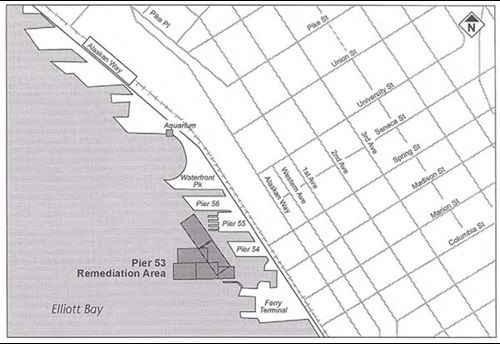In March 1992, contractors for the U.S. Army Corps of Engineers (the Corps) placed 22,000 cubic yards of clean sand offshore of Piers 53, 54, and 55 in Elliott Bay on Seattle’s downtown waterfront, capping 4.5 acres of chemically contaminated bottom sediments.
This action, known as the Pier 53 project, was the culmination of over four years of study and planning by many agencies, including the City of Seattle Department of Engineering, the King County Department of Natural Resources and Parks (KCDNRP) (formerly the Municipality of Metropolitan Seattle, or Metro), the Corps, the Washington State Department of Ecology (Ecology), the Washington State Department of Natural Resources (DNR), the Washington State Department of Fisheries, and the U.S. Environmental Protection Agency (EPA).
Project background
Planning for a remediation project along the Seattle waterfront began as part of Metro’s Toxic Sediment Remediation Program, which was formed to coordinate and plan multi-agency efforts to clean up contaminated sediment in Elliott Bay and the lower Duwamish Estuary. An interagency committee was formed to provide guidance for this program. The Denny Way sediment cap—located north of Seattle’s downtown waterfront—sponsored by Metro, and constructed in 1990, was the first project completed under the Toxic Sediment Remediation Program.
The first major step in planning a new sediment remediation project along the Seattle waterfront was to contract Parametrix, Inc. to conduct a risk assessment and prioritize a list of 49 potential sites. The list was later expanded to include sites in the Duwamish River for a total of 68 sites. The sites were ranked on the basis of the number and types of chemicals present and the maximum concentration of these chemicals. Of the initial 49 sites, the two highest ranked sites were Seacrest Park, located south of the Seacrest Marina on the West Seattle side of Elliott Bay, and the Pier 53 site. A preliminary remediation plan was developed for these two sites as part of the Parametrix report (Parametrix, 1992).
The City of Seattle and Metro decided to develop the cleanup plans and coordinate with regulatory agencies during the permit process. The Corps was committed to complete dredging in the Duwamish River by the end of March 1992 and would dispose of the sand at the open water disposal site in Elliott Bay if no beneficial capping project was possible. Because of this dredging schedule, the time frame for acquiring the necessary permits for capping and the review period for the permitting agencies were very short. All permitting agencies were cooperative, and all permits for capping were obtained.
After Pier 53 capping was complete and the Elliott Bay/Duwamish Restoration Panel was formed (the Panel), the project was presented to the Panel. The Panel reviewed the project and, after deciding it met certain criteria, declared that the project was eligible for credit towards the 12 million dollars allocated to sediment remediation projects as required under the consent decree. The management of the Pier 53 project then proceeded under the direction of the Panel with the City of Seattle as project sponsor. Metro, and now King County DNRP, agreed to conduct the monitoring program, which was established during the permitting process.
Vicinity map

The project site is an east-west-trending, roughly triangular area located offshore of Piers 53, 54, and 55. The site is west and slightly north of the intersection of Madison Street and Alaskan Way in downtown Seattle. The project consists of a 3-foot-thick sediment cap covering the 2.9 acres farthest offshore and to the south and an experimental 1-foot-thick enhanced natural recovery area covering the 1.6 acres nearshore and to the north.
Project library
Pier 53-55 Sediment Cap and Enhanced Natural Recovery Area Remediation Project 2002 Data and Final Report, June 2010 (3.2MB)
The purpose of this report is to document the methods, results, and conclusions of monitoring conducted on the Pier 53 project site in 2002 as part of the monitoring program established for the project. In addition, this report presents a comparison of all the monitoring data collected in 1992, 1993, 1996, and 2002 and discusses the monitoring results within the context of the program objectives.
Additional reports:
- Pier 53–55 Sediment Cap and Enhanced Natural Recovery Area Remediation Project (EBDRP, 1993)
- Report and Appendices
- Pier 53–55 Sediment Cap and Enhanced Natural Recovery Area Remediation Project 1993 data (EBDRP 1995a)
- Pier 53–55 Sediment Cap and Enhanced Natural Recovery Area Remediation Project 1996 data (EBDRP 1997)

 Translate
Translate